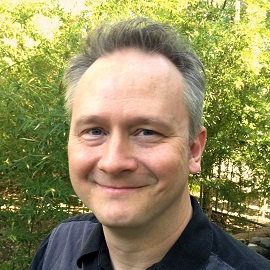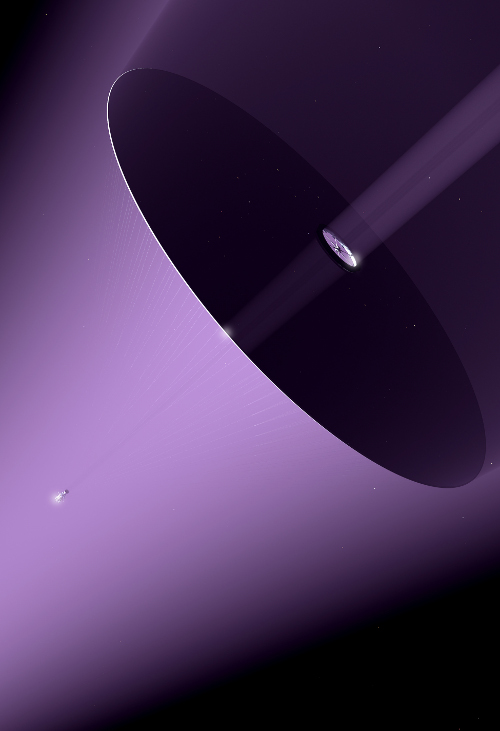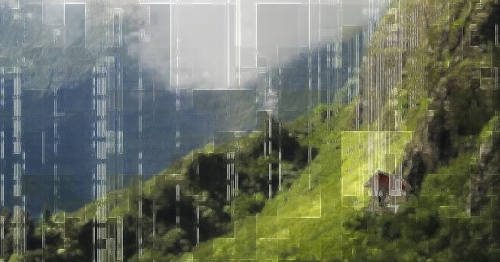Librarian and futurist Heath Rezabek has become a familiar figure on Centauri Dreams through his writings on existential risk and how our species might counter it through Vessels, installations conveying our planet’s biological and cultural identity. The Vessel concept is far-reaching, and if we build it on Earth, we would likely take it to the stars. But in what form, and with what purpose? Enter the lightsail starship mission Saudade 4, its crew — some of whom are humans by choice — nourished on the dreams of a continually growing archive. Heath’s chosen medium, the essay form morphing into fiction, conjures the journey star travelers may one day experience.
by Heath Rezabek

I’ve described The Vessel Project in four prior posts:
August 29, 2013 – Deep Time: The Nature of Existential Risk
October 3, 2013 – Visualizing Vessel
November 7, 2013 – Towards a Vessel Pattern Language
December 13, 2013 – Vessel: A Science Fiction Prototype
As I began preparing my paper on the Vessel project for the 2012 100YSS Symposium, one of the first things to occur to me was the potential crossover between the project’s goals and some of the functional requirements of a starship. While at heart a Vessel installation would be a comprehensive archive, the capacity of such a thing suggested so much more. I’ll explore these other facets through essay and fiction in coming installments.

Figure 1: Sailship – Adrian Mann (Used by Permission).
Providing a guiding intelligence for a starship would entail quite a lot. One role facilitated by a comprehensive archive would be that of ambient intelligence, a pervasive sentience throughout the craft. We can envision a starship as a layered technology, with data storage systems as one core element, surrounding habitat systems (however abstracted towards mere life support) as a surrounding space, and computational capabilities infused throughout like a nervous system.
Within this model, duties might include providing for the crew, whatever form that crew may take. We can envision miniaturized crew, artificial crew, biologically engineered crew, hibernating crew: all of these and more (unless completely inchoate or unconscious for the duration, as in a case where the crew is actually a cargo of nascent or embryonic humans) might make use of some kind of virtual environment in which to exercise their minds and their conscious needs.
In his paper “Transition from Niche Decision Support to Pervasive Cybernetics,” also presented at 100YSS 2012, Patrick Talbot detailed a framework for a cybernetic nervous system to be woven throughout a ship, as a self-aware knowledge base. It would need to be capable and flexible to handle the many functions needed of such a craft. The Artificial Intelligence Module (AIM) suggested by Talbot has some interesting qualities, including the design goal of deriving new patterns (“unknown unknowns”) through abstracting structured stories from its knowledge base. [1] Talbot’s model, along with a real-world creative writing exercise I’ve used in workshops, inspired aspects of Avatamsaka, the synthetic mind in this story fragment.
An archive that was comprehensive enough, and that included the means to sample from its contents and yield novel outputs not envisioned by its compilers, could conjure up whole worlds of the imagination for its dependent crew. This would of course yield a vast probability space for exploration, and also for assimilation of the contents of that archive over time.
It also lets us explore the Simulation Argument, [2] while providing one relatively benevolent answer to the question of why such comprehensive universe simulations might ever be run: To provide space and time for a passenger’s mind to roam. Thus, in addition to providing fertile ground on which to play out the unfolding of myriad possibilities in endless combinations, this fictional scenario also provides a counterpoint to cases in which a simulated universe would seem a cruelty. [3]
Here, I explore some of these themes, and touch on more to come.
[1] Talbot, P. “Transition from Niche Decision Support to Pervasive Cybernetics,” 100 Year Starship 2012 Symposium Conference Proceedings, 143-154 (2013).
[2] Bostrom, N. “The Simulation Argument: Are You Living in a Computer Simulation?” (http://www.simulation-argument.com). Accessed January 2014.
[3] Searle, R. “The Ethics of a Simulated Universe” (http://utopiaordystopia.com/2013/03/17/the-ethics-of-a-simulated-universe). Accessed January 2014.
Woven Light: Adamantine

Figure 2: Mountain Shelter – Heath Rezabek
The sun was a golden haze, settling down upon this shambles by the sea. Near, inside a pilgrim’s shelter, Mentor Kaasura nodded at last light as it draped over hills and low roads, long since overgrown.
He had been seated there for much of the afternoon, sheltering from skittish rains. Before him, not far as a man might hike, lay the nameless, ruinous complex. Rusting generators brooded; breached coolant towers numbly gaped at the tumbling forest which scaled Iron Mountain to their west; behind their backs grey waves heaved and raked indifferently at the remains of its foundations.
None had lived here, or anywhere near these sleeping, vacant forms, for several generations; yet not far away, these timber shelters remained, small shadows crouching on the paths which faded into the hills. These leaning structures, maintained as they were by pilgrims of several sorts, each hosted a strange assortment of stowed and forgotten things.
Some of these were maps, through dreamlands now believed to be exposed here. Some were meditative texts, guiding the mindful reader towards countless branching worlds. And some were simply manuals on how to move through wilderness or doubt in a feral world.
But Mentor Kaasura had come in here clear of mind, free from fear, and had found this particular lean-to in the way he still recalled. Slowly stalking up the hillside, as the path around him crumbled into overgrowth and tussock, he had passed from shade to shade while lining up the old wayfinding beacons with ones more distant, until they drew a line upon which the distant Oiinu Arcology seemed to balance like a domed and lidded platter. And then, hardly needing to turn to enter the door, he sat to begin his meditations.
Clear and distant, a voice from before: ~If you go there, you’ll never return.~ His sister’s entreaty had seemed dismissive at the time, but hearing it again, through the lens of all their time before, he could see it had been a simple observation. Seasons returned; people returned. But time could not be rewound. Though things returned, they did so changed. He too would return, but the part of him that made the pilgrimage would recycle itself transformed. And so Kaasura sat.
He was here to ponder cycles. Though years were stretched long now, and little seemed to change from day to day, he knew from his own Mentor that there once had been a time when upheavals had seemed constant. The means to shape the world had unfolded and enfolded those who’d lived through that time, leading on to many things; even, yes, the crumbled generators now sinking into the valley below. He was here to ponder the means by which cycles stretched and snapped short.
But he was also in this place because he knew that here, the veil that braced the delving deeps was worn thin; and that this particular shelter, hugging the ragged mountain wall behind him, was a secret feint, a camouflaged diversion. He knew that he sat before an opening driven deep into the mountainside; he could feel a flow of slow sentience flooding the hut, streaming outwards from far behind him, and he shivered on his stump.
He could hear it just as well: a kind of sighing, or so he imagined. And so with eyes closed, to set imaginings aside, he began the traditional meditation on what still was called mortality; he saw himself standing out upon the road, then turning around to face the hut and him within it, standing firm as he gazed at the shelter, the brooding clouds above, the whispering shoots that crowded on all sides; and he saw himself clearly, seated there, facing out, eyes still shut.
And reaching down, as gently as he could, he took from his imagining hands a small and shimmering shard of knotted light, and bowed.
Stepping then beyond himself to enter this collapsing roof of a room, he faced the rear wall’s faded hanging, woven dense with interlacing. Beyond, he knew, lay the narrow channel through its iron-laden stone, walls dense with carven alcoves, splaying inwards into countless caverns and rivulets and grottos.
Mentor Kaasura paused, watching his outbreath. He committed to memory as much as he could of the tapestry’s patterned weave. Then blinking, his checkpoint saved, he stepped within.

Figure 3: Mountain Shelter (Detail) – Heath Rezabek
– – –
By the mid-21st century, Project Avatamsaka had yielded the most robust synthetic mind ever conceived. To that point, swarm AI had shown some promise, and conscious aggregate drone-clouds had several times surmounted emergency response situations which had left other systems dismayed. Newer and greater challenges had in time sparked the rising of new minds to meet them.
Avatamsaka was different. For this system had to lend spirit to a starship, with all the agency that implied. Design decisions had been made which only in hindsight could be seen as more than the sum of their parts.
Avatamsaka presented itself as a unitary consciousness, though not always as the same one. Depending on the approach of the crew member, Avatamsaka could appear as either female or male, and to varying degrees; its range of personalities would waver when first approached, until settling into a fairly stable persona while dealing with any one person. The logician would confront a transcendent algorithm. The vain would confront an inscrutable foil. And the dreamer would stand face to face with an imagination unending.
This kaleidoscopic impact was not entirely by design: the mind had been built to stay adaptive, and couldn’t have been otherwise, but the scale of adaptation was wholly unplanned and had come from Avatamsaka hirself.
Hir central core was not unique; there were copies and backups in various places, each a singular starting point for sentient aggregation. Like seeds, data cores could be planted within a digital mesh, and would bloom from within. These simple seeds had come from another project altogether, but as Project Avatamsaka had worked itself up to speed, it was seen that the one could easily benefit the other.
Each cubic lattice was called a Vessel cache, and their sizes varied greatly. Though they appeared quite the opposite, at simplest any one of these cores could be modeled as a black box. The outside world went in, and was drawn back out in fragments, glimpses, sketches, connections found between the elements emerging and new wholes reassembled on the fly.
In this way, it turned out to make an excellent foil for the pattern-finding at which Avatamsaka excelled.
The basic process of concept discovery and reconstruction was called pattern-sampling (or patterning), and could be experienced (in principle) as a kind of a game. Thus:
– Take your nearly-infinite deck of cards, with nearly-infinite things on them. This is your Vessel.
– Draw any number of samples. (Let’s say 5.)
– Identify just over half of them as most readily related or relatable. (Let’s say 3.)
– Discard the outliers. The remaining set is your glimpse of knowledge, your pattern-sample. Do with it what you will.

Figure 4: Pattern Sample – (public domain elements)
– – –
The ultimate aim was for Avatamsaka to use these sets to perform all the tasks and functions of a living lightsail starship. For a starship on an extended voyage, the tasks are many, and most of them are mission-critical as the time window for potential failure is so wide. But among these tasks, one of the less critical yet more complex was the augmentation of reflexive dreamworlds for the crew to experience during the voyage. “Crew” was an interesting term by the time the four ships called Saudade set sail. Certainly, what amounted to petri dishes outnumbered the astronauts. A minority of the crew was what we would have called human, and most of those people were people by choice.
——-
The Avaai had chosen to remain in human form, albeit an optimized one. If there had been a reason, these crew in theory could have navigated the actual physical spaceframe of Saudade IV. But there were also a slim few, who had chosen to be set into stasis entirely, as their bodies were barely augmented at all. These were the Ghemaai, and their choice would have been a tremendous burden had they not been an archival decision in the first place.
As things stood, they were no more a burden in their hibernating forms than the tanks of lastline biomass sampled from Earth’s biomes. And like their wild kin, even in their stasis, the Ghemaai could dream.
Or delve, as the term was. This state was unlike what we’d have recognized as dreaming, as much of the source material for these inner lives was drawn from the nearly-infinite stores of the Vessel cache by Avatamsaka, vented in pattern-samples to the nervous systems of all who slept, whether Avaai or Ghemaai.
When the nearly-infinite range of pattern-sampled impressions contained within a Vessel cache was blended with the nearly-infinite intuitive capacities of a sentient being, novel things happened. For the purposes of the crew of the Saudade IV, the most novel of these was the simple fact that through these means, generations of lives could be lived out in seeming, in complete immersion, flowing starwards through space.
One of the family lines enmeshed in this way bore the last name of Ramer. But only one of the lightsails in the first fleet bore those folk as crew or cargo, and as you may have guessed by now, this was Saudade IV. We can guess that there were at least four such craft in that fleet; but we can’t know if there were more, or where this leaves the other three.
~We can’t even know if there truly were three others to start with~ mused Odiah Ramer, when first he thought it through. But he was delving deep in the weave of the Avaai at the time, and before the lesson arcs had been patterned to guide fretful minds, this place was a disorienting place to be.
– – –
Somewhere in spacetime, Avatamsaka glides through the depth between stars, clad only in a lightsail named Saudade.

Figure 5: Sailship (Detail.) – Adrian Mann. (Used by Permission.)



To think that Artilects will be humanity’s servants is even more absurd than thinking that dogs will become our masters.
We are just a stepping stone to a higher form of intelligence. Most humans are just too limited and self-focused to accept otherwise. It is a much better “fate” than what humanity would have in store for us otherwise (degeneration to extinction). At least we serve a purpose with a real, tangible goal.
Artilects will do a much better job at understanding the Cosmos, finding other intelligences, and communicating with them. It will not be at all surprising if the ETI they do find are versions of themselves, not the organic talking types self-confined to a single planet.
“Humans should not stand in the way of a higher form of evolution. These machines are godlike. It is human destiny to create them.” – Hugo de Garis, as quoted in New York Times Magazine of 1 August 1999, speaking of the Artilects of the future.
If humans do not build Artilects, it will be for the same reason we do not have starships: Not because it is impossible, but because many do not want them for a variety of reasons, including the shock and fear of something that will dethrone the self-perceived importance of the human species.